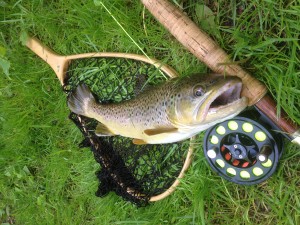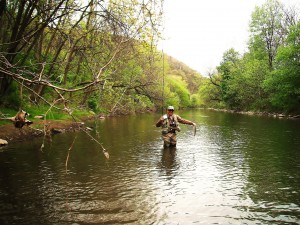Meeting of Little Juniata River Association November 12, 2013
Tyrone Public Library, 7:30 p.m.
Fourteen people were present including members, directors and guests. They assembled to hear a presentation by Dr. Hanna Stout regarding her efforts to reintroduce Green Drake mayflies to Spring Creek..
Several potential new LJRA members attended including Troy Duprey, General Manager of CENVEO. Troy is an avid fly fisher and he has joined us as our newest LJRA Life Member.
Dr, Hannah Stout, an aquatic entomologist, described her graduate research project the goal of which was to determine if Green Drakes could be established on Spring Creek, Centre Cty. Green Drakes are present in 50 streams in PA; their nymphs are of the burrowing type which grow in gravelly riffles. Her preliminary studies showed that the water quality of Spring Creek is good enough to support Green Drakes, that there is sufficient gravel substrate, and that the macro invertebrate community in the stream is appropriate. In 2009 she obtained permission from PF&BC to attempt an experimental reintroduction of the Green Drake.
Dr Stout aided by volunteers, has trapped thousands of adult female drakes containing eggs from Penns Creek. The eggs have been introduced to Spring Creek at The Rock stretch for the past 5 seasons. Her goal is to see if a self-sustaining GD population can be established. Her research indicates that it will take at least ten years of transplanting before such a determination could reasonably be made. In 2011 she found one GD nymph in the gravel at The Rock but she hasn’t found another since. There followed a discussion of the project including the history of the GD on the Little J as well as possible places on the Little Juniata River at which a GD reintroduction could be attempted.
Stream Bank projects – Director, Carl Reed, reported that the stream bank improvements made this Summer near Pine Croft are doing well and that the knotweed spraying seems to have been effective. The seedlings planted also seem to be having a good survival rate.
Opportunities – President Anderson said that a primary goal of LJRA is to find ways for more cold water to be introduced into the LJ – such as by bottom releases from impoundments as well as by eliminating impoundments that presently allow tributary water to warm.
Threats – Another issue is the likely incursion of negative impacts in the LJR watershed from the mining and drilling industries. One such incursion is a proposed waste fill site adjacent to the Sandy Run wetlands near Pinecroft to be used for the disposal of fracking drilling waste. The project will be challenged and the permitting process, etc., will need to be examined closely. Bill Anderson and Gary Miller met with Jim Frey, engineer for Mountain Research and a landowner at the site. He described the disposal project to them.
HB 1576 – the goal of which is to substitute the PA IRRC for the PA F&B and Game Commission with regard to environmental oversight of certain private industry extractive efforts.. LJRA is very concerned about this bill. It is presently in Committee. LJRA sent a letter to legislators expressing opposition to this legislation which will lessen the ability to protect wild trout populations discovered by PFBC. Director, Bill Bressler commented on the state of this issue, which he has been following closely. Members John Corr and Andy Yablonsky attended the committee hearings in Harrisburg and also visited with their representative to protest the passage of HB1576.
Fall Boat Float River Cleanup: This event was held October 26 in low water conditions. A great deal of refuse was collected, including 60 tires and tons of other trash. After first agreeing to do so, the Huntingdon office of Penn Dot refused to pick up this refuse. Park’s was contracted to pick it up at a cost of $360.00. A motion to pay this bill was made, seconded, and passed.
The LJRA spring river bank clean-up for 2014 will be held on April 5th, 2014. It will be the 10th annual LJRA Spring River Bank Clean-up.
Sandy Run – Bill Anderson and Bill Bressler met with Tyler Nieman of the PA F&B Commission and two DEP representatives to tour the Sandy Run wetlands site. The purpose was to consider the best way to eliminate the warming effect of the shallow pond once used as part of a trout hatchery. The best solution may be the widening of a presently existing breach, allowing the large springs to bypass the pond altogether..
Award – LJRA President Bill Anderson was presented with an award at the recent Blair County Conservation District meeting. He was named as the “Conservationist of the Year 2013”. Bill stated that the award is also to acknowledge the work of the LJRA as a whole. Congratulations Bill!
Didymo – There is a report of didymo in the upper branch of Pine Creek. LJRA Director, Joe Reese observed that such reports are not conclusive as the underlying studies are rarely done with the thoroughness required to truly evaluate the likelihood of a problematic didymo infestation.
Treasurer’s Report – Charlie Hoyer presented written statements for the LJRA NFWF and General Checking Accounts for the period 4/1/2013 – 11/12/2013 including present balances.
President Anderson described the NFWF Grant and stated that LJRA filed its report of the use of these funds in October. The balance of $6,927.59 must be spent by December 2013 or be relinquished.
He also described the Public Fishing Easement Grant awarded to LJRA. All but $12,000.00 of this $200,000.00 grant was used to obtain permanent easements from landowners along the river. LJRA has funded nearly 5 miles of such easements. The remaining $12,000.00 was returned to the PA F&B Commission.
The Treasurer’s Report was presented by treasurer – Charlie Hoyer
Meeting adjourned. Notes by Carl Mulica
Notes by Carl Mulica.


